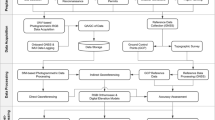Abstract
This paper presents the comprehensive results of landing site topographic mapping and rover localization in Chang’e-3 mission. High-precision topographic products of the landing site with extremely high resolutions (up to 0.05 m) were generated from descent images and registered to CE-2 DOM. Local DEM and DOM with 0.02 m resolution were produced routinely at each waypoint along the rover traverse. The lander location was determined to be (19.51256°W, 44.11884°N, −2615.451 m) using a method of DOM matching. In order to reduce error accumulation caused by wheel slippage and IMU drift in dead reckoning, cross-site visual localization and DOM matching localization methods were developed to localize the rover at waypoints; the overall traveled distance from the lander is 114.8 m from cross-site visual localization and 111.2 m from DOM matching localization. The latter is of highest accuracy and has been verified using a LRO NAC image where the rover trajeactory is directly identifiable. During CE-3 mission operations, landing site mapping and rover localization products including DEMs and DOMs, traverse maps, vertical traverse profiles were generated timely to support teleoperation tasks such as obstacle avoidance and rover path planning.
Similar content being viewed by others
References
Ouyang Z. The primary science result from the Chang’E-1 probe. Sci China-Earth Sci, 2010, 53(11): 1565–1581
Xiao L. China’s touch on the Moon. Nat Geosci, 2014, 7(6): 391–392
Li R, Squyres S W, Arvidson R E, et al. Initial results of rover localization and topographic mapping for the 2003 mars exploration rover mission. Photogramm Eng Rem S, 2005, 71(10): 1129–1142
Arvidson R, Anderson R, Bartlett P, et al. Localization and physical properties experiments conducted by Spirit at Gusev Crater. Science, 2004, 305(5685): 821–824
Zakrajsek J, Mckissock D, Woytach J, et al. Exploration rover concepts and development challenges. In: 1st Space Exploration Conference: Continuing the Voyage of Discovery. Orlando: AIAA, 2005. 1–23
Golombek M, Cook R, Economou T, et al. Overview of the Mars Pathfinder mission and assessment of landing site predictions. Science, 1997, 278(5344): 1743–1748
Golombek M, Anderson R, Barnes J, et al. Overview of the Mars Pathfinder mission: Launch through landing, surface operations, data sets, and science results. J Geophys Res Planets, 1999, 104(E4): 8523–8553
Li R, Di K, Matthies L H, et al. Rover localization and landing-site mapping technology for the 2003 Mars Exploration Rover mission. Photogramm Eng Rem S, 2004, 70(1): 77–90
Parker T, Malin M, Golombek M, et al. Localization, localization, localization. In: 35th Lunar and Planet science conference, abstract, Woodlands, 2004. 2189
Cheng Y, Maimone M W, Matthies L. Visual odometry on the Mars exploration rovers-a tool to ensure accurate driving and science imaging. IEEE Robotics Automation Mag, 2006, 13(2): 54–62
Maimone M, Cheng Y, Matthies L. Two years of visual odometry on the mars exploration rovers. J Field Robot, 2007, 24(3): 169–186
Di K. A review of spirit and opportunity rover localization methods (in Chinese). Spacecraft Eng, 2009, 18(5): 1–5
Di K, Xu F, Wang J, et al. Photogrammetric processing of rover imagery of the 2003 Mars Exploration Rover mission. Isprs J Photogramm, 2008, 63(2): 181–201
Zhao J, Huang J, Qiao L, et al. Geologic characteristics of the Chang’E-3 exploration region. Sci China-Phys Mech Astron, 2014, 57: 569–576
Jia Y, Liu S, Li M, et al. Chang’E-3 system pinpoint landing localization based on descent image sequence (in Chinese). Chin Sci Bull, 2014, 59(19): 1838–1843
Wan W, Liu Z, Di K, et al. A cross-site visual localization method for Yutu rover. In: ISPRS 2014 Technical Commission IV Symposium. Suzhou, 2014. 279–284
Liu J, Ren X, Mou L, et al. Payloads and scientific experiments of Chang’E-2 lunar Orbiter (in Chinese). Life Sci Instruments, 2013, 11(2): 31–38
Ouyang Z C. Chang’E-2 preliminary results (in Chinese). Chin J Nat, 2013, 35(6): 391–395
Zhao B, Li C, Huang J, et al. Analysis on in-orbit CCD stereo camera images of Chang’e-2 lunar satellite (in Chinese). Spacecraft Eng, 2012, 21(5): 1–7
ASU. Chang’e 3 Lander and Rover From Above (J/OL). Secondary Chang’e 3 Lander and Rover From Above (J/OL), 2014, 2014(Agust 28): http://wms.lroc.asu.edu/lroc/viewlroc/LRO-L-LROC-2-EDR-V1.0/M1147290066RE
Liu Z, Wan W, Peng M, et al. Remote sensing mapping and localization techniques for teleoperation of Chang’e-3 Rover (in Chinese). J Remote Sensing, 2014, 18(5): 971–980
Lowe D G. Distinctive image features from scale-invariant keypoints. Int J Comput Vision, 2004, 60(2): 91–110
Fischler M, Bolles R. Random sample consensus: A paradigm for model fitting with applications to image analysis and automated cartography. Commun ACM, 1981, 24(6): 381–395
Peng M, Di K, Liu Z. Adaptive markov random field model for dense matching of deep space stereo images. J Remote Sensing, 2014, 18(1): 77–89
Peng M, Yue Z, Liu Y, et al. Lunar and Mars orbital stereo image mapping. In: Proc SPIE. Hangzhou: SPIE, 2010. 820304
Di K, Liu Z, Yue Z. Mars rover localization based on feature matching between ground and orbital imagery. Photogramm Eng Rem S, 2011, 77(8): 781–791
Morel J, Yu G. ASIFT: A new framework for fully affine invariant image comparison. SIAM J Imaging Sci, 2009, 2(2): 438–469
Wan W. Theory and Methods of Stereo Vision Based Autonomous Rover Localization in Deep Space Exploration (in Chinese). Beijing: Chinese Academy of Sciences, 2012
Author information
Authors and Affiliations
Corresponding author
Additional information
Recommended by XIAO Long (Assoicate Editor)
Rights and permissions
About this article
Cite this article
Liu, Z., Di, K., Peng, M. et al. High precision landing site mapping and rover localization for Chang’e-3 mission. Sci. China Phys. Mech. Astron. 58, 1–11 (2015). https://doi.org/10.1007/s11433-014-5612-0
Received:
Accepted:
Published:
Issue Date:
DOI: https://doi.org/10.1007/s11433-014-5612-0




